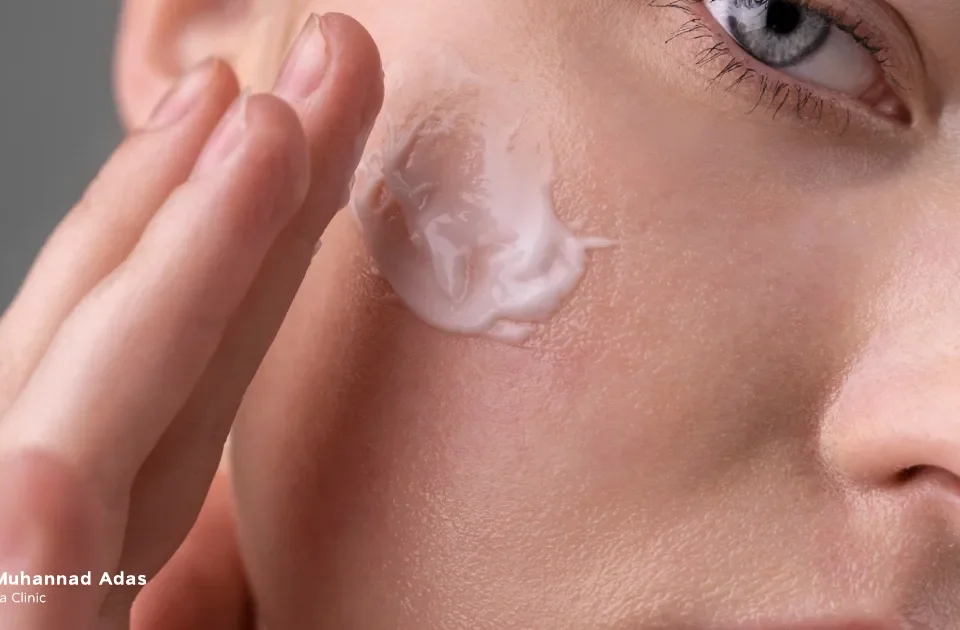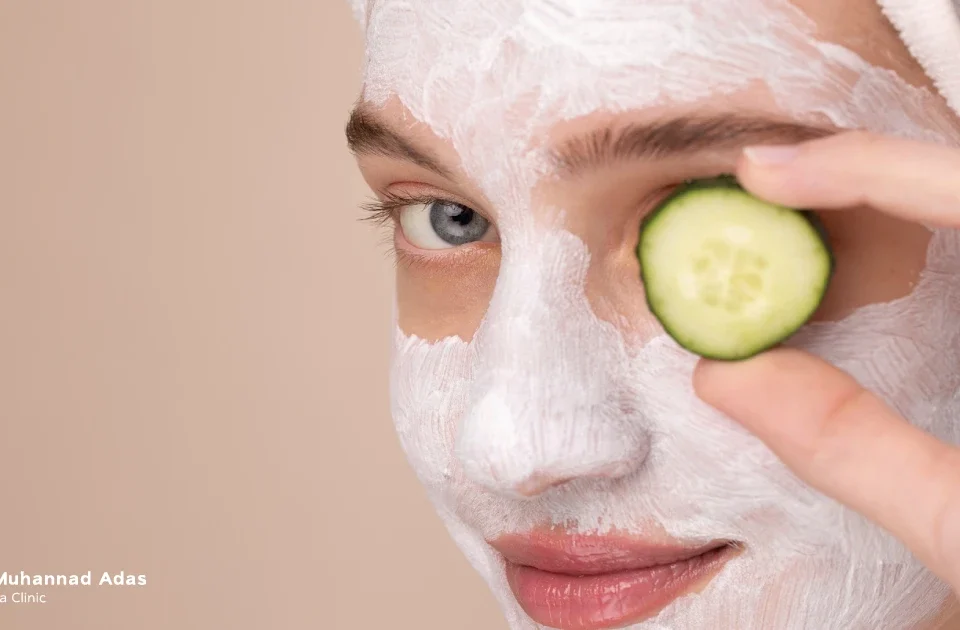Table of Contents
I suffer from skin peeling and an unappealing appearance, and I often strive to moisturize it and create homemade masks, only to find that it absorbs all the moisturizers and returns to its previous dry state! I don’t know what I should do or how to solve this problem… This is what one of our clients expressed when she raised her issue with dermatologist, Dr. Muhannad Adas, she inquired about the best cosmetic treatments and instructions necessary to improve her skin condition. This should be determined by the doctor based on an examination of your skin and selecting the most suitable treatment for your case.
How Do I Know If My Skin is Dry?

The most prominent signs of dry skin include:
- Roughness of the skin.
- Itching sensation (a strong urge to scratch).
- Skin irritation and tightness.
- Discomfort after swimming or bathing.
- Peeling and cracking of the skin.
- Difficulty applying makeup.
- Appearance of small pores.
- Lower oil secretion in the skin.
- Dryness in various parts of the body.
How Does Dry Skin Look Like?


How is Dry Skin Treated?
Natural dry skin treatment
It is very important to consult a dermatologist or specialists on the best ways to manage dry skin. However, some instructions can be applied to help reduce its annoying symptoms and maintain hydration as much as possible, including:
- Many find that ointments are essential for those with dry skin as they are more concentrated. It is also recommended to use moisturizers containing hyaluronic acid, lanolin, shea butter, and petroleum jelly.
- Reduce the frequency and duration of showers and it is preferable that they do not exceed 10 minutes.
- Avoid skincare products that cause dryness due to their ingredients. Creamy formulations are preferred.
- Wear gloves when cleaning or when you are exposed to detergents and water.
- Use a soft towel when drying your body. Make sure to gently pat your skin dry instead of rubbing it vigorously.
- Increase water intake to enhance hydration in the skin.
- Shave hair in the proper way and direction. Moisturize your skin before and after shaving.
Medical dry skin treatment
How is dry skin treated in clinics?
- Hydrafacial technique, to soothe and deeply hydrate the skin, is considered a perfect solution to nourish the skin with beneficial ingredients.
- Various treatments such as clinic-based skin cleansing, can calm the skin, effectively apply masks & moisturizers, and perform gentle exfoliation.
- Incorporating hyaluronic acid, known as the king of hydration, it can enhance skin elasticity alongside other treatments when applied topically or injected.
- Exfoliation sessions in clinics, improves the skin’s appearance by removing dead skin cells. This treatment also effectively prepares the skin to absorb moisturizers and serums more efficiently during the session.
Read also: Exosome skin injections: All you need to know before considering the procedure
Why are Ointments Better than Creams for Dry Skin?
Because ointments contain a higher concentration of oils compared to creams, making them more effective for dry skin. Additionally, ointments are less likely to cause skin irritations than creams. It is preferable to use ointments that consist of mineral oils, jojoba oil, shea butter, as well as those containing hyaluronic acid, glycerin, and petroleum jelly (vaseline).
Causes of Dry Skin
What affects dry skin?
- Exposure to heat and various environmental conditions, such as cold or humidity.
- Excessive exfoliation and showering.
- Certain types of soaps and detergents.
- Skin diseases, such as eczema and psoriasis.
- Receiving certain medical treatments.
- Aging, as the skin becomes thinner and produces less oil.
How Do I Get Rid of Facial Dryness?
Wash your face twice daily and moisturize it at least twice in the morning and evening. Use alcohol-free and non-foaming cleansers. Additionally, make sure to wash and moisturize your face after sweating, which can occur due to physical activities or exercise. You can also choose products that contain both linoleic acid found in argan oil and stearic acid present in shea butter, as these can help hydrate your face.
Skin Dryness in Winter
Cold winds and outdoor air, along with various heating methods, can significantly contribute to your skin’s dryness. The key steps you can take to protect yourself from dry skin in winter are:
- Maintain a healthy diet that promotes your skin’s health by including foods such as fish, avocados, almonds, sweet potatoes and others.
- Ensure adequate water intake, as it greatly impacts your skin’s elasticity and hydration.
- Regularly use skincare products like serums and moisturizing creams.
- Cover most of your body when exposed to cold and frost conditions.
Read also: How to take care of your skin in winter?
Dry Skin Disadvantages
There are many symptoms that affect dry skin, causing discomfort for those who have it and requiring certain instructions and procedures to protect it from dryness. These include:
- Increased skin irritation & sensitivity, especially when exposed to external environmental factors and interacting with skincare products containing soap.
- Peeling skin that feels rough, leading to discomfort for individuals with dry skin and a less smooth appearance.
- Itching sensation, which can further damage the skin.
- Cracks and inflammation, as these fissures can allow bacteria to enter, increasing the risk of infections and inflammation.
- More noticeable fine lines.
- Difficulty absorbing moisturizers, as dry skin tends to absorb them quickly, necessitating frequent application.
- Dull appearance of the skin, lacking radiance and freshness.
- Compatibility with certain types of products, as some may be specifically suited for dry skin, helping to maintain hydration, though they might be somewhat expensive.
What is The Difference Between Normal Skin & Dry Skin?
First, what is normal skin? It is skin that maintains balanced levels of moisture and oil secretion effectively. In contrast, individuals with dry skin may experience increased tightness, and their skin often appears rougher and duller. Additionally, dry skin produces less sebum (a waxy oily substance produced by sebaceous glands) compared to normal skin.
How Many Times Should Dry Skin Be Moisturized?
Twice, moisturize your face, neck and body in the morning and evening, using circular motions to enhance absorption. You should use non-greasy products or those with high moisture content or gels to ensure that you maintain high hydration levels for up to 24 hours. Additionally, you can consult a dermatologist to find out which products are most suitable for dry skin.
Knowing the solution can save you many steps in your treatment journey… So, are you now ready to face dry skin after reading this article? If you need consultations and to find the best treatment plan for your condition, contact the clinic of dermatologist Dr. Mohannad Adas at +962799377600
Stay updated with our latest news in the field of cosmetics and dermatology on our website: dradas.com





